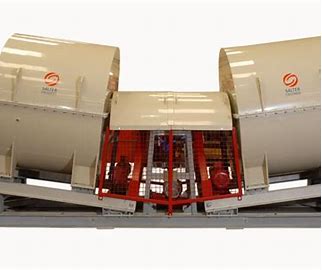Sign up for daily news updates from CleanTechnica on email. Or follow us on Google News!
Under the auspices of the India Smart Grid Forum, the think tank founded as an umbrella organization over India’s 28 state utilities to provide thought leadership, share leading practices, and bring international insights to India, I’m delivering bi-weekly webinars framed by the Short List of Climate Actions That Will Work. With the glories of online recordings and AI transcription tools, it’s relatively easy to share both the transcript, and also the slides that I used, so I’m making a habit of it.
Most recently, I delivered a talk and held a Q&A session covering the challenges facing nuclear generation in modern times and why it’s mostly a distraction in terms of climate action, not a climate solution. For those who prefer talk-talk to read-read, here’s the recorded video of the presentation and discussion.
Thank you to ISGF for giving me the privilege of sharing my insights to assist the great country of India to find the challenging path between increasing affluence for its country and for its forest, but also for decarbonization. And so today’s topic in the many discussions we’ve had in this seminar series is nuclear energy. And I’m going to start with something which may seem counterintuitive given the title of the presentation, which is that I like nuclear energy as a technology. It is low carbon, it is reliable, it is safe, and it is low pollution. I am not particularly concerned about any of those things. The question is, how does it compete with other technologies?
As a reminder for people who have been participating in these seminars, I assess things on the trifecta of technical viability, economic competitiveness against alternatives, and will people accept it? And it isn’t the technology, the feasibility, that is challenging for nuclear, it’s the economic competitiveness. And so let’s get through some of this and potentially we’ll have a good discussion at the end of it.
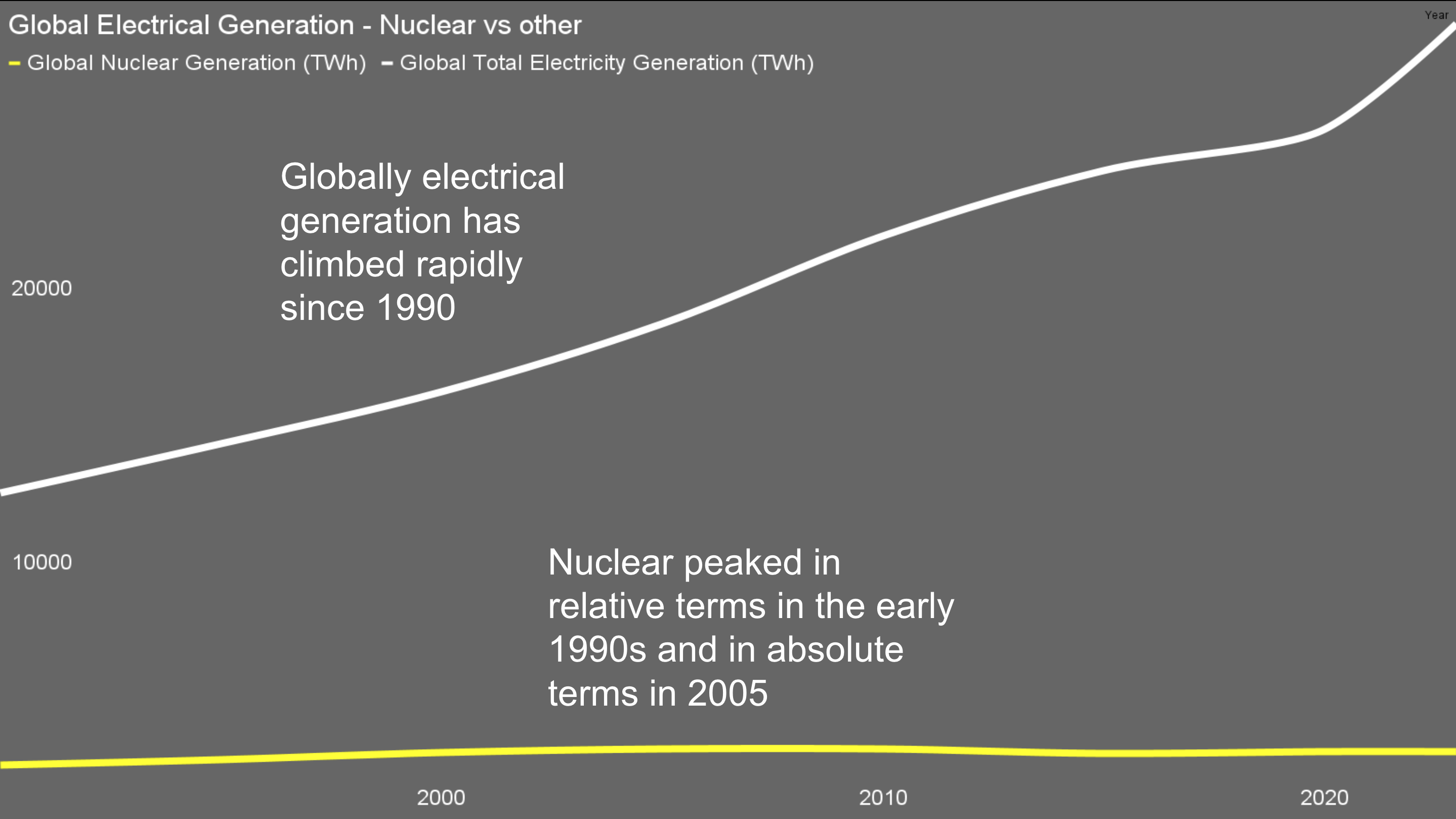
So let’s start with the really obvious things. Electricity has been growing incredibly rapidly for a long time. Electricity, as I like to say, is the future for all energy.
Earlier discussions were Electrifying Everything Everywhere All at Once, for example, because electricity is the most efficient way to deliver the most energy to actual stuff we value, whether it’s heat pumps, which get three units of heat for a unit of electricity, or whether it’s transportation, which is three to four times more efficient in battery electric form than internal combustion form, or whether it’s just LED lights. The most efficient way to deliver heating and electricity globally has proven to be electricity. Everything that can electrify will. And so electrical generation has upwards in every country in the world, including India.
And yet nuclear energy, despite its technical advantages, peaked in relative terms as a percentage of global electricity in the early 1990s, in absolute terms, in 2005. So what’s going on? I’ll just say that from a market perspective, if a product had peaked in terms of market share in the early 1990s and hadn’t increased that since, we’d be saying, why are we even talking about it? And yet we do talk about nuclear quite regularly when it comes to electrical generation. Once again, that’s because of the attributes it does have, which are positive. It is low carbon, it is low pollution. It’s much better to have a nuclear plant running than a coal plant, but we just don’t have very many of them. So that’s the global perspective. Be let’s a little more narrowly focused. Let’s look at the Asian context.
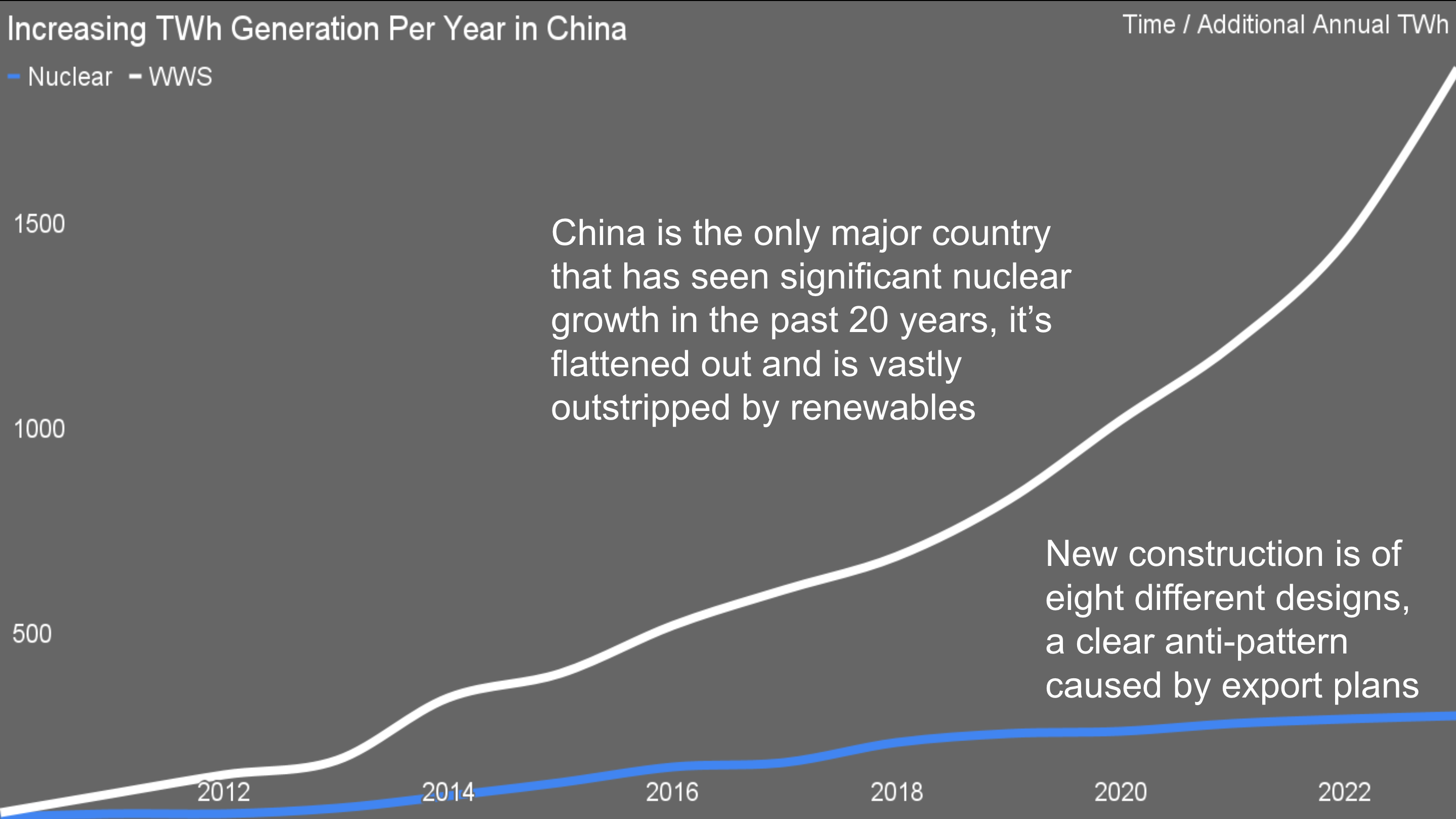
Now, this is China stuff. I’ll get to specific stuff on India shortly, but as we consider China, let’s think about China. China has built 177,000 highways since 1987. It’s built over 500 cities from scratch. In the past few decades, it’s built 30,000 to 40,000 dams. In that similar period of time, it’s built 45,000 kilometers of high speed electrified rail. Clearly, China knows how to mobilize capital, resources, and technology to successfully deliver enormous numbers of megaprojects. And that includes massive amounts of renewable energy. Last year, China deployed 274 gigawatts of solar and wind capacity, and is on track this year to deploy more.
Yet in that country, which knows how to do megaprojects — and nuclear projects are megaprojects — they’ve only managed to build 55 nuclear reactors since they started in 1970. There are apologists who say Fukushima put a kibosh on a bunch of stuff. But the program started in 1970. The first commercial nuclear reactor was on the grid in 1991, and Fukushima was 20 years after that. The actual deployment of nuclear in China does not align at all with the success of other megaprojects. Something is different here.
The white line is renewables. Over the similar time frame, I picked 2010 because the renewables program had been in place for five years by then. And so it was mature enough to start comparing to the clearly very mature nuclear program, which had been around for 40 years at that point. And yet renewables have vastly outstripped nuclear deployment. Once again, this gets to the competitors as we look at the country in the world with likely the most compelling conditions for a successful scaling of nuclear. We don’t see successful scaling of nuclear and instead we see a very significant loss of absolute and relative market share compared to renewables.
To be clear, China has built a lot of coal plants as well. That flat line along the bottom is actually flatter. If we put that in every year from now on, regardless of what China does, and it’s doing a lot, is we are going to see that line at the bottom get kind of closer to the horizontal axis as it becomes less and less relevant in terms of China’s generation mix. Right now. I just published a significant article on that. You can look that up in CleanTechnica or on my LinkedIn profile. They have approved eleven reactors, and that sounds like a lot. And that’s actually 31 reactors they’ve approved for construction since 2022. They have 30 reactors in construction, which sounds again like a lot, but 30 reactors in construction due to be finished by 2029. And by the way, I consider that a fairly unrealistic construction schedule. 30 reactors is only about 30 gigawatts of capacity over the next six years. Meanwhile, they’re putting in 300 gigawatts of capacity, ten times as much every year in renewables. And so once again, it gets back to that economic competitiveness argument.
I’ll also point out that there’s that interesting point, the 30 reactors they have in construction are eight different designs, and that will become relevant as we move forward through this discussion.
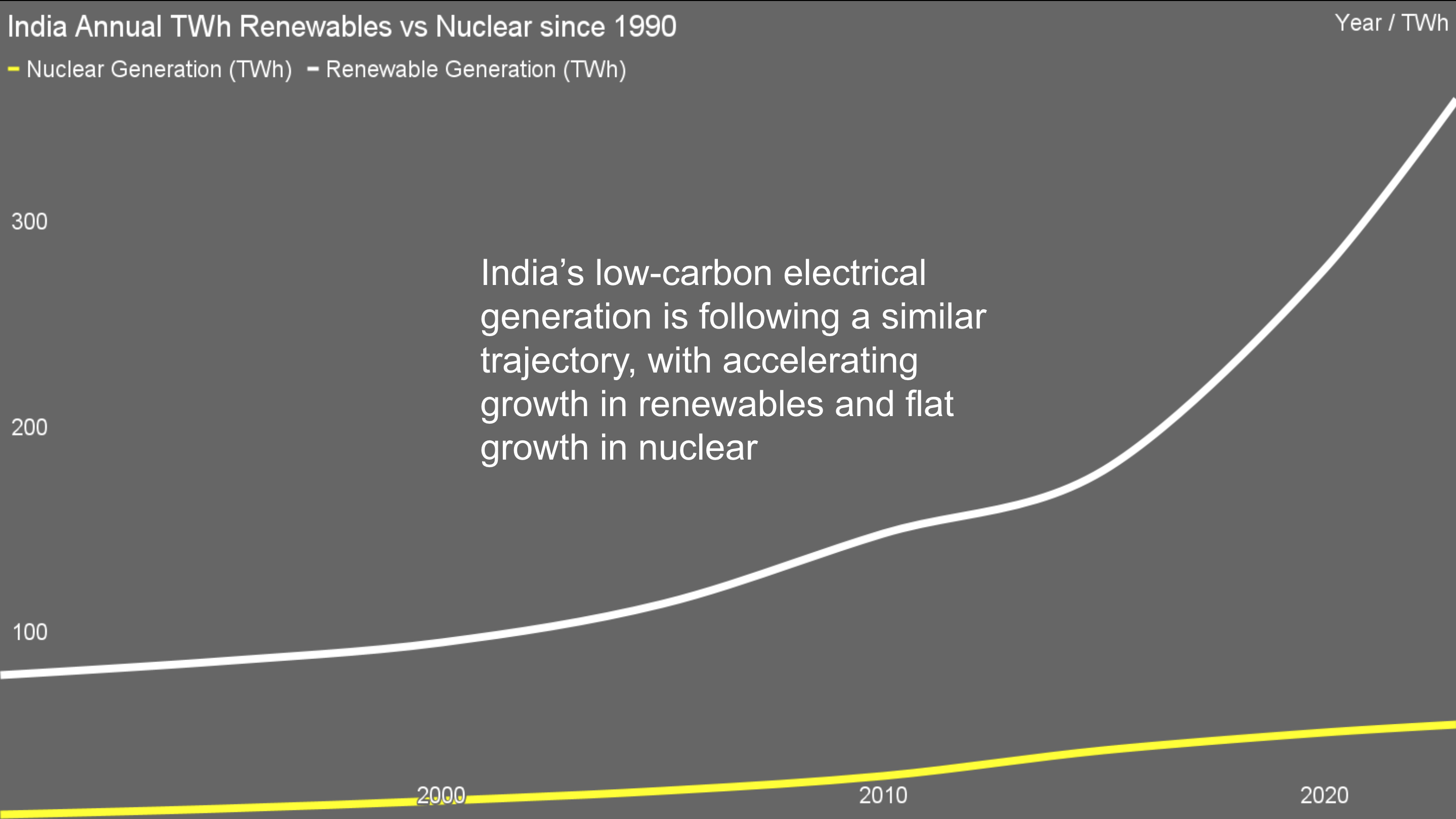
So let’s look at India. Here’s the same kind of chart for India. This is renewable generation, the white line, and nuclear generation, the yellow line. Now, nuclear in India has been a little bit more of an upslope than it has been in China, but it’s also a lot less in terms of absolute values.
You’ll note this is fairly low in terawatt-hours of generation. In terms of actual generation, we’re at 500 terawatt-hours. So that is in the 50 terawatt-hours of annual generation versus China being in the 500 terawatt-hours of annual generation from nuclear. Meanwhile, we see that India has increased rapidly, especially in the past ten years, in terms of deployment of wind and solar, especially so. In China and India, two emerging economies, we see a very significant market success of renewables and a lack of comparative market success with nuclear.
And I’ll be clear on both of these charts. What I’ve done is I’ve taken the capacity factors of, in the case of China, I actually worked it up from capacity, the capacity factors of those technologies, and looked back through that time. I went and found statistics for terawatt-hours for wind, solar, and water in India versus nuclear in India for the past 30 years. And so that’s what’s represented on this chart. And so, once again, this is actual generation from these technologies.

So here’s a chart from Our World in Data, a very useful site. I recommend that if you haven’t spent time trolling through some of its stuff, it’s helpful in terms of us understanding what’s going on. This chart looked at statistics of the price trajectories, the cost trajectories of different generation technologies.
You can see coal here. There’s no learning rate for coal. Basically, in 2010 to 2019, it stayed about the same price. And that’s understandable. It’s a very old technology, burning carbon-rich dirt, and thermal generation isn’t something where a lot of innovation is going to change stuff in terms of reducing its cost. We have much better coal generation now with high quality coal that’s washed appropriately, pulverized, put in the appropriate coal generation plants, but much better is still horrible compared to the alternatives. Solar voltaic is stunning. 2010 to 2019, we see this plummeting in the price of offshore, you know, in offshore wind. Also a significant reduction in price for the levelized cost of energy. And onshore wind is even flatter now. Of course, solar has continued this curve, as has onshore wind, but now they’re down in 2023 at roughly equal. Solar and wind are dirt cheap forms of technology.
And to be clear, the global, what people are calling the problematic global glut of solar panels means there’s a tremendous opportunity for developing nations to buy a lot of cheap solar and implement it and win big because of that. And so an obvious recommendation for India is to buy a lot of the solar panels that are wandering around the marketplace, as Pakistan is. It turns out they’re doing an amazing job of putting up rooftop solar.
But to call this out, because the discussion point today is nuclear energy. Let’s look at the learning curve from 2010 to 2019 for nuclear energy. It’s going in the opposite direction. Now, statistically, we can look at this since about 1970 and see that this is true. As we deploy new nuclear plants, they’re getting more and more expensive. They’re not getting cheaper. This is a really odd curve. It’s almost unique in technology, deployment, and processes. As we deploy more, everything gets cheaper, not the other way around.
And there’s a bunch of reasons for that. So let’s pick those apart a little bit. So, first of all, deploying nuclear, and I’ll get into all the conditions for success, requires repeating exactly the same design over and over and over again, so that the teams know how to do it, are capable and experienced, the lessons learned can be deployed. This is true for solar and wind. And to be clear, a solar panel from one of the big Chinese firms is the same as a solar panel from any other Chinese firm. The variance between products is extremely low. A solar panel of one design is trivially different than a solar panel of a different design. That’s not true for nuclear plants.
There’s an enormous number of operational and technical considerations that go into every design of a nuclear plant where there’s variance, and that’s true in capacity and nuclear technology. And so, once again, you have to limit yourself to doing the same thing over and over again, or something with very small variances in order to get those learning curves. Wind turbines are obviously the same as well. While there’s some variances in terms of the nacelle of a wind turbine, in terms of what’s inside it’s still just a nacelle. It gets delivered, it gets winched up to the top of the mast, the blades get attached. It’s actually a trivially different variance. And when we implement a wind or solar farm, we’re doing the same thing over and over and over again in the solar farm or the wind farm.
And so the teams that are actually building those gain expertise and skill on the first five or ten strings of solar panels or wind turbines that they apply to the rest of them. And there’s all sorts of automation. There’s mast climbers and there’s cranes and there’s trucks that are specially designed to move these components into their places. In many places now, heavy lift drones are carrying solar panels to hillside mounting locations, zipping back to pick up another one, zipping to the mounting place, dropping the solar panel off into the waiting hands of the installers. And so we get all sorts of efficiencies from replicability and parallelization of deployment. Whereas a nuclear plant, a nuclear reactor takes six to twelve years to build, sometimes longer.
And you have to build all of it and turn it once there is little replication of effect inside the nuclear plant. So you have to build a lot of reactors that are identical in order to gain those lessons learned. Unfortunately, what happens is we end up with significant challenges, Chernobyl and Fukushima, which cause everybody to get quite concerned about nuclear energy. And typically, that’s the big things that we see. One study of nuclear energy found there were an enormous number of small challenges that occurred that could have been bad, but weren’t. And so as we learn more about nuclear energy, we learn more about the stuff we really don’t want to have happen.
The other thing is, nuclear physicists and nuclear engineers are incredibly bright people. They are men and women who want to do bleeding-edge stuff. They want to do the best possible stuff. And so they, unless they’re tightly controlled, they change things for the better. And changing things for the better in nuclear is not the right solution. Innovation is the enemy of nuclear energy. Somebody asked me on LinkedIn earlier today around this topic. “Mike, do you have a preferred technology and design for nuclear?” I said, no, it’s, you know, but we’ve got a big handful from the 1990s that were fit for purpose. They were safe, they were reliable, they’re gigawatt-scale, they’re effective. If we just built all of those, we wouldn’t have had to build nearly as many coal plants as we built. But there are other challenges with nuclear beyond that.
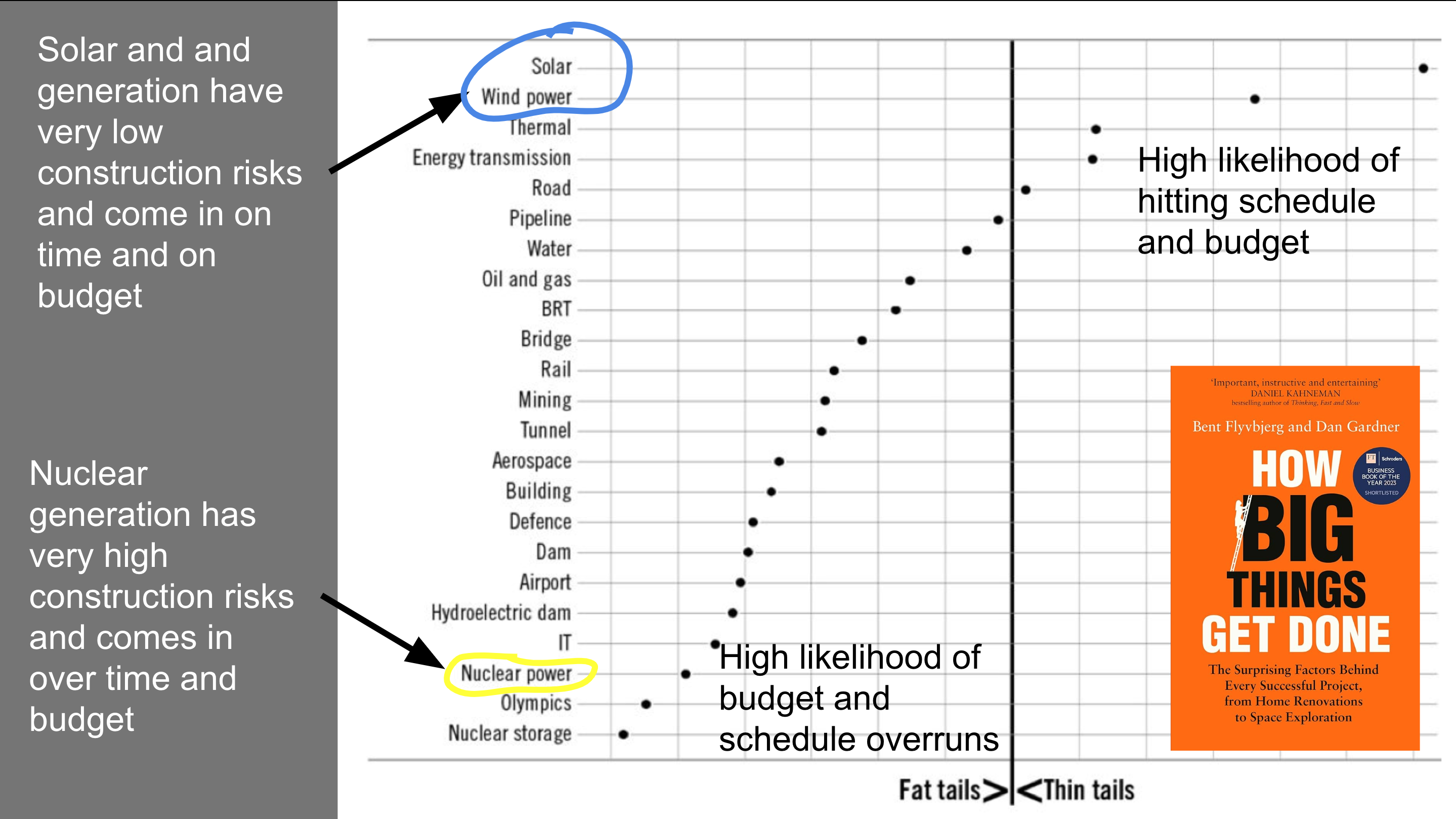
For those of you who haven’t read How Big Things Get Done by Professor Bent Flyvbjerg and Dan Gardner, I strongly recommend it. Flyvbjerg is an academic and consultant and a Danish knight, of all things, who is a global expert on megaprojects. He started assembling datasets with his team in the 1990s of billion dollar plus projects. Their first publication had about 250 megaprojects, sufficient for some statistical analysis. And it was the only dataset in the world that had that — nobody else was gathering this data. And so now he has over 16,000 megaprojects in his data set, including over 150 nuclear projects globally. That’s out of about 500, 600 in the world and so it’s a very representative set. He also has a lot of solar, wind transmission, etcetera.
He and his team have broken this down into 25 categories, and the categories come out of consulting engagements work with governmental agencies that are looking to do significant transportation, IT, or energy projects, all of which he and his team have consulted on. Let’s just pick something neutral in the middle here. Let’s pick hydroelectric dams, fairly far down the list. Hydroelectric dams have a very strong likelihood of going over budget, over schedule, and not delivering the benefits they were supposed to, per the statistics of the megaprojects in the category.
He and his team, over the past 25, 30 years, have gathered high quality data on megaprojects. They reject megaprojects where they can’t ascertain the budget and the schedule and the expected benefits initially with a high quality, and then get the actual costs time to construct them and the benefits accrued. And so the 16,000 plus projects have high quality data, and they’re able to do statistical analysis on them, because he publishes in peer-reviewed journals, and they demand high quality of these things to say which ones are the most likely to achieve time, budget, and benefits. He has something called the iron law of projects. The iron law of projects is that only 0.5% of projects achieve budget, time, and benefits. 99.5% of billion dollar plus projects don’t achieve all three. The trifecta is really hard. That’s the base rate.
But as we consider from an energy perspective, what we see is statistically, solar and wind projects are way up here. Solar especially is by far the least likely during construction to run into risks which derail the project. That’s a key thing. Flyvbjerg talks about long-tailed risks versus short-tailed risks. A long-tailed risk is a risk statistically, which has inordinate impact if it occurs. And you can quantify statistically from his data set, which projects have more long-tailed risks than which ones don’t. Solar and wind have very few long-tailed risks. Once you start construction, it’s on ground, it is pretty straightforward, it’s a highly parallelizable solution. Solar, especially, can use relatively unskilled labor to do most of the work. It’s highly automatable, it’s subject to replicable automatable steps.There just isn’t much that can go wrong with a wind or a solar project in construction compared to other things.
Some of that is because they don’t take very long to do a lot. When Flyvbjerg and I talked initially, it was just stunning to him that it’s now possible to build a gigawatt offshore wind in the North Sea, which is a tremendously inhospitable oceanic environment, in ten months. That’s a gigawatt in ten months, that’s a megaproject, total construction time, ten months. It is almost unique for megaprojects historically to be that fast. A fast megaproject historically was 4 to 5 years. But in wind and solar, that scale of project is months. And if the project duration is only months, a lot less can go wrong in the surrounding environment.
You’re much less likely to have, for example — I don’t know why this occurs to me — a war break out in Ukraine while you’re in construction of a wind or solar farm than when you’re in construction of a nuclear plant. Shorter durations reduce risks is one of the key observations. But there are other concerns as well. Like for nuclear power, you will notice that it’s 23rd in the list of categories of going over budget and over schedule. This is true for all the data that he has, and it was true for India’s deployments as well. India had some significant cost and schedule overruns in its deployments of technology. I’ll get a bit more into that as we go forward.
One of the ways to look at this from a choice of technologies perspective is to say, what is the lowest risk for actually achieving benefits and hitting schedule and hitting costs? Well, wind and solar. What is the highest risk? Highest risk means you have to apply a lot more contingency and you have to do a lot more effort to achieve that. You have to apply a lot better resources, a lot more care and skill, and you’re going to be paying a higher cost of capital.
And even then, it’s not going to be short. The construction plans in China for the 30 reactors they have under construction, about 30 gigawatts of capacity, is an average of 6.6 years. I did the math yesterday. So 6.6 years from the point when the shovel first goes into the dirt to the point where it’s finished construction and connected to the grid, that’s 6.6 years for capacity that in wind and solar can be done in less than a year. That’s over six times, almost seven times as long for something to go wrong in the business environment, in the capital environment, in the geopolitical environment, the supply chain environment, etcetera. Once again, I like nuclear. It’s hard to say it’s competitive, given this risk profile.
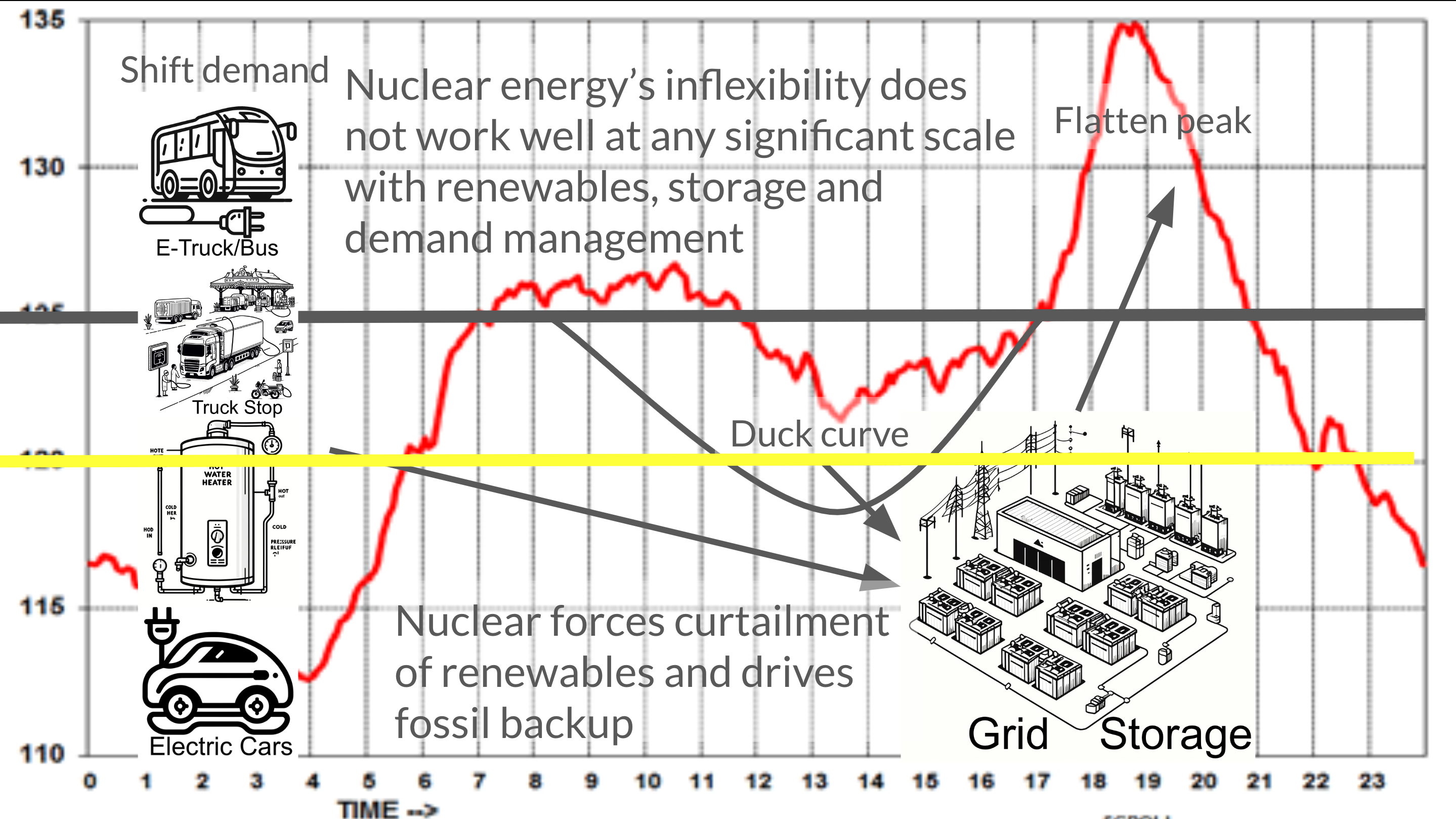
So let’s talk about this in the context of India. This is a chart that I did from an earlier seminar, excluding this yellow line. What I talked about at that point was saying that globally, in the developed world, the distribution grid is about 50% to 60% utilized, which means that we could double the energy flowing through our distribution grids. Except that we have lots of peakiness. This is an Indian chart of the daily demand cycle for energy in India. And you’ll see that it’s very spiky, it’s got lots of troughs, things like that.
And what we see as we go forward in time, this bar will use demand management, storage, and other techniques to push the capacity of the grid up and flatten it so that more energy flows through the distribution wires a lot more of the time. And as we do that requires flexibility of demand and it requires flexibility of supply. You have to have something that you can turn down or off in terms of supply if you have to, and it won’t impact the business case substantially. Now, if we take supply management in the United States, as I described in an earlier seminar, the way the United States treats its gas plants, its natural gas cogeneration units, peaker demand or peaker supply. So they are the generation of last resort.
If there’s wind and solar on the grid, for the majority of the United States, they supply the energy and it’s low carbon and it’s low cost. Some of that is just the economic merit order. Merit order means they go first, but the most expensive generation sets the price. Wind and solar get that price, which is why they’re benefiting. But that means they’re providing this peak, and this peak with gas and supplying the rest of it with wind and solar. In China, they’re using their coal plants the same way. They’re the generation of last resort. They run them in a flexible mode and that flexibility becomes very important.
The problem with nuclear is it’s technically and economically inflexible. Gas and coal plants are economically flexible because if you don’t run them, you’re not paying for the fuel you’re putting into them, you’re not losing much money. There’s just money to keep the lights on. But the big expense for coal and gas plants operationally is the coal and gas you’re shoveling into them. Wind and solar are flexible because, well, once you’ve got them, the wind and sun are free if you turn them down a bit or turn them off for a bit. While you’re not losing any money, you’re not spending any money particularly. They’re much cheaper to have sitting still in a coal or gas plant where you have to do a bunch of work. But they’re flexible in terms of just a SCADA control to turn them up or down.
And because they’re so cheap to build, if we use them suboptimally, it doesn’t really impact the systemic cost that much. Needless to say, we want to curtail them as little as possible. India has done a very good job of that, because unlike Europe and North America, you actually built a lot of capacity of transmission, expecting a lot of capacity of wind and solar in specific places. And so you don’t have the curtailment problem that the west has had. China has done something very similar, built a lot of transmission. They’ve had a very low rate for the past few years. They’re creeping up again with increased curtailment. And so they’re going through now and looking through some stuff there. India is doing the same thing.
But Europe and the United States have been very slow to build transmission by comparison. However, that flexibility, whether economic or technical, doesn’t apply to nuclear. Nuclear is very expensive to build. It’s so expensive to build, in fact, that it needs to operate at 80% to 90% capacity factors to be a profitable technology. If you turn it down economically, you lose a lot of money. You start messing with your business case quite rapidly, you lose the benefits. And so you have to build nuclear with the expectation of running it at 90% capacity factors in order to have a business case. That interferes with the flexibility required by very cheap renewables. And so you can’t build very much nuclear before you start impeding the flexibility required in a modern grid.
There are also technical challenges. There are many types of reactors that can do some load following, none as much as wind or solar when the wind is blowing, the sun is shining. And so there are some, in many cases for a lot of nuclear designs, where if you turn them up or down too rapidly, you poison the core and you actually have to do a whole bunch of stuff. What that means is it is used for baseload generation and baseload generation load. The clue is in the word. That’s a demand statement. Our grids are becoming more peaky as we move into very different demand cycles. Used to be that there was an industrial heavy industrial demand, and then a bit of consumer demand and commercial demand on top of that. Now there is this very spiky commercial and residential demand, and fairly small industrial demand by comparison in most places.
And so we need more flexibility than we had, so any baseload is smaller. And so what we end up with this yellow bar, which is intended to represent here to assist in understanding this, is that nuclear starts blocking the advantages of a flexible grid. In a modern grid, if it’s built in significant capacities, you can get away with 5 or 10%, but it used to be you could probably get away with 40%, but now it’s diminishing. There have been techno-economic analyses on this. I read another one just recently that basically said you can build flexibility services around nuclear, but it’s more economical not to bother with the nuclear component of the grid and just build more wind and solar.
And so as we keep moving forward and nuclear does not get cheaper, and wind and solar do get cheaper, and transmission is proven, and storage is proven for wind and solar, it’s just not. And demand management is proven. Nuclear is losing its economic competitiveness in this regard on modern grids. So there’s fascinating stuff there. I encourage people to go and read more about the challenges of the inflexibility of nuclear. And to be clear, there are people who disagree with me. They disagree typically because there are nuclear designs that can be turned up and down, they can load follow, but they ignore the economic side of that, or the people who have the economic side, who limit their discussions to loaded geographical regions and try to cherrypick a place where it does make sense.
And there are people who are saying, well, where we have heavy industry that does have a significant load, we should put some nuclear plants there. It’s not a bad argument, but nuclear plants require a bunch of conditions for success. And industrial sites aren’t necessarily going to spend the money for a nuclear option. They haven’t done it so far, so why would they do it in the future? There is another case where if you have a coal plant and you build nuclear capability on that coal plant, you get to reuse the transmission and a bunch of the skilled thermal workers, and there’s an argument for that. But there’s also a lot more people replacing big coal areas with a lot of solar and storage in the coal plant, and achieving 90% of the benefit for 20% of the cost and duration. So it’s hard for me to justify most of the arguments.

So let’s get into the conditions for success for a nuclear program. Now, this is an historical perspective. What I’ve done is I, over the past, you know, decade and a half, two decades, as well as my perspective coming from Ontario, which has a bunch of nuclear reactors, and in Canada, and having, you know, traveled in France and, you know, spent a lot of time in the United States looking at this. We’ve seen scaled nuclear programs in the past. We’ve seen cases where we’ve built a lot of nuclear capacity compared to the amount of generation on the grid in a fairly short period of time with reasonable economics, as far as we know.
I tend to point to the United States, 100-odd reactors they built since the 1950s. I tend to point at France, which, you know, has 75% of its demand, in theory, met by nuclear. I tend to point at South Korea, and I tend to point at the UK, the United Kingdom. They’ve done reasonably well at this. And there are a few things which become clear as you look at all these examples and then look at the counterexamples that are occurring in the 21st century. First of all, it was a top priority national goal. Typically that was because there is a significant threat of nuclear war. They needed to develop their own nuclear deterrent. And as such, they had bipartisan or tripartisan support for a nuclear commercial generation program, that strong military engagement for a nuclear program to enable them to have a guarantee for 20 to 30 years that they would have support for the costs of those things.
They would share some of the costs for the commercial generation with nuclear weapon programs, because as you enrich uranium with centrifuges and stuff, well, at a certain point it becomes fit for commercial generation. At another point it becomes fit for nuclear weapons. And so as we look around the world, there’s a strong tendency for, during the Cold War, when the USSR was a nuclear weapon capable superpower, for a lot of countries to build those capabilities. In South Korea more recently, well, North Korea is the scary monster that required them to have the ability to build a nuclear deterrent. And so we see those types of things need to be a top priority national goal, need it to be something that everybody agrees and needs to do. And that comes with some other things.
You need national control of all the deployments. And typically that means a bunch of military discipline about the construction schedules. You need to have a strong focus from the national level with highly committed and experienced people driving the suite, all the construction timeframes, all the construction plans. And you have to have, you’re not going to delegate that down and kind of have somebody keep an eye on it. This is a strong control, not a keep an eye on it from above type of thing.
With that comes national human resources initiatives. Now, when I say that, what I mean is they have to build university programs and technical training programs for nuclear engineers, construction workers, scientists, and have that as a national goal. Have national certification of resources and have national security programs for resources as well. You don’t want sketchy people building a nuclear reactor
For solar farms, some of the solar developers I’ve spoken to say, yeah, for a lot of our labor, we just go to the corner in the city that we’re near, and we pick up seven guys in our panel van and we drive them to the work site, and they are there for 12 hours, and we drop them back at the corner and we pay them minimum wage in cash. That’s not what you want to do with a nuclear plant. The human resources thing has to be carefully controlled, and the skills of the resources for constructing a nuclear plant are much higher. There’s some overlap, but even then you don’t take a coal plant construction worker and turn them into a nuclear plant thermal generation construction worker just by driving them to the site. You have to go through a whole bunch of certification training.
You have to give them the understanding of radiation. You have to make sure there’s security, make sure they’re not a gambling problem. That’s going to turn into something which becomes, you know, an industrial or national concern for security. So those are all the governmental, national-scale conditions of success.
Then over here, a single proven gigawatt-scale design. Once again, I already talked about why you just need to repeat something over and over again to get the learnings, to get the lessons learned. You have to just keep repeating the same thing in order to share the knowledge and succeed at accelerating deployment and de-risking it and reducing the costs of it. So I’ve talked about that one enough.
Building dozens. You can’t build two. You have to have 24 to 100 reactors in the program in order to spread the significant costs of the first few across the deployment of the rest.
And so you’ve got to build them fairly quickly. You have to build a lot of them, and then you have to build them fairly rapidly, in 20 to 40 years. The successful programs have been a maximum of 40 years because you get young people in at the beginning and they stay in construction of nuclear reactors their entire careers, and they retire having built a bunch of nuclear reactors. You’ve got this ability to create a skilled set of resources and maintain them through time and reward them for success. And they bring that knowledge over and over again. And further, the best of them emerge as the people who elevate up to keep control of multiple reactors as they move forward. And so that you end up with this resource pool that is enabling itself and the old and experienced people train and apprentice the under people. You can’t do that. If you spread it through 100 years and you do a reactor every other year, you’ve got to do a bunch of them in a relatively short period of time, and then you got to be done, or you got to start again.
Then no local innovation, all that control. You just have to keep those really bright, experienced, often PhD-level resources from making things better. Because in nuclear, making stuff better makes things worse. You really have to have incredibly tight project control on changes and a really strong focus on not making changes.
If you look at the history of modern nuclear reactors in the United States, they failed miserably to do most of these things, but that was one of the key ones they just kept doing, approving change requests for, oh, this would better. The costs balloon out of control. That’s true for Europe as well, where they had their European pressurized reactor, which has its own problems because they didn’t pay attention to the conditions for success.
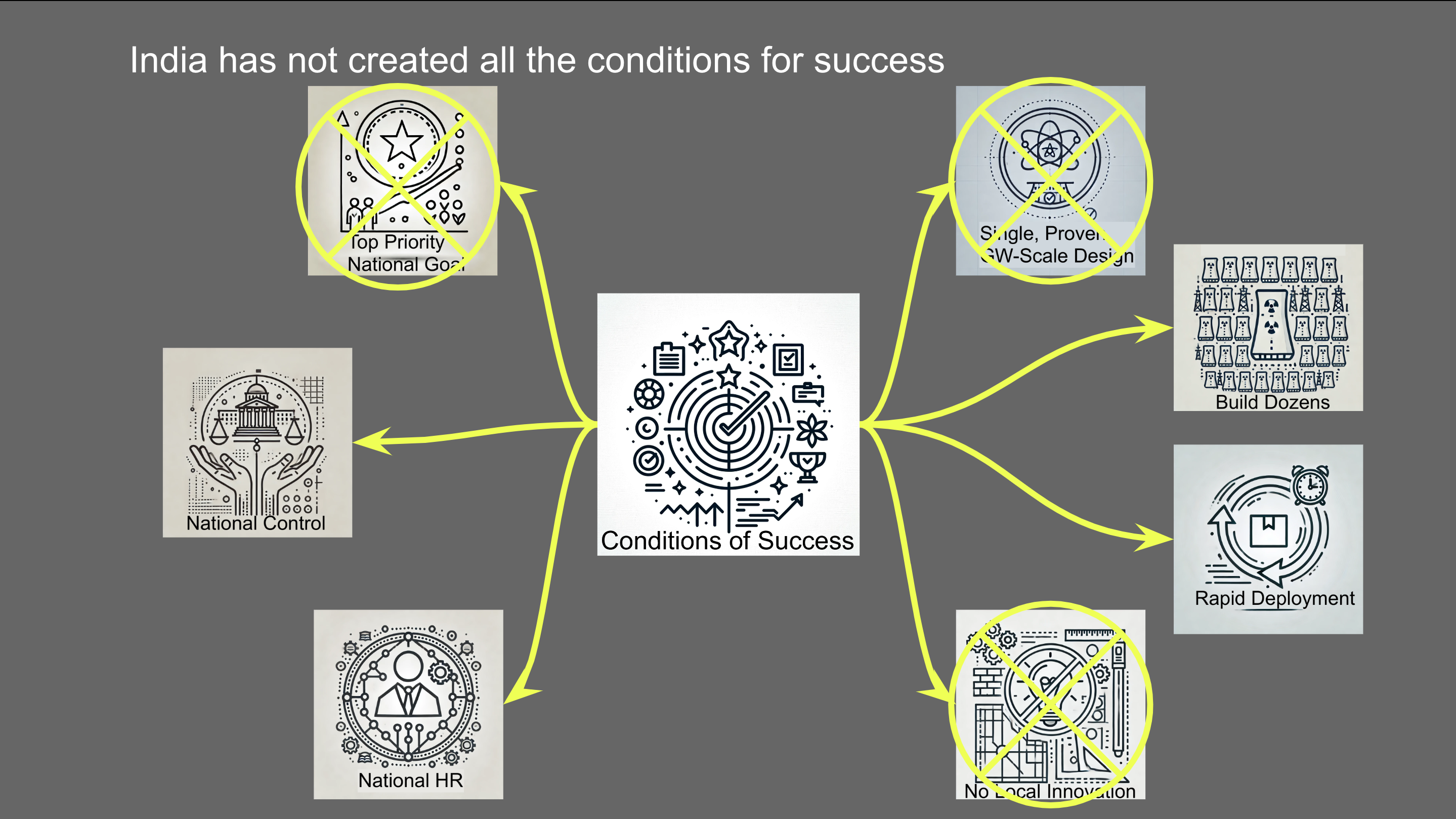
So here’s India. India has not created all the conditions for success for scaling nuclear reactors. I went through a bunch of material in the past couple of days, and please feel free to tell me I’m wrong, but according to what I’ve been reading, it’s a secondary goal to build nuclear programs, not a top level national priority right now, which means it’s not getting the attention it needs.
Now, it does have national control, it does have national resources. So, yeah, you’ve created more of the conditions for success in India, but it’s not the top priority. It’s not a top level priority for the organization, and that’s reasonable. The threat of nuclear was is low. India is already a nuclear armed country. The threat of actual nuclear war in the region just isn’t that high these days. You have other concerns than global thermonuclear war and mutually assured destruction. You’re trading a lot with all the countries that you are in some degree of conflict with. Trade with China is quite high. Trade with your neighboring countries, regardless of whether you are beating the drum with them or not, is quite high. You’re actually doing a lot of travel back and forth between all these countries in your part of the world.
The world is a trading organization. One of the best things that has occurred since World War Two is, well, everybody trades with everybody. If India had stayed isolationist and internally focused, with a strong sense of independence, perhaps, but it’s sort of liberalizing its markets in the early 1980s, and now it’s a trading country as much as anybody else.
So building dozens. Yeah, you’ve got a lot of reactors. Rapid deployment. Yeah, you did some of that. You licensed CANDU reactors from Canada, for example, but local innovation, you kind of failed on that one. The single proven gigawatt-scale design. You didn’t do that. You’ve got a lot of different designs from a lot of different manufacturers.
A lot of them are small, like the CANDU reactor technology licensed from Canada. A lot of those are in the 300 megawatt range, which is probably at the bottom end of the viable scale. And just in terms of some of the thermodynamics of it, and just all the fiddly bits to link together, all the fittings, screws, pipes, the number remains the same, but they just get smaller and smaller. And you have to do it many more times with more reactors. It’s just not efficient. And so no local innovation. You had poor control, as far as I can tell, historically, over the individual sites to prevent them from messing with the design and not trying to improve it or adjust it for local conditions or local suppliers. And so you had cost overruns and a bunch of other stuff. Still not that bad.
And to be clear, if India made this a top priority national goal, picked a single proven gigawatt-scale design, eliminated all the rest, and applied very strong change control to force limitations, you could have a scaled nuclear program. I don’t see you having done that yet. And bluntly, no country in the world has done that successfully in the 21st century. So India is not alone in that. The conditions for nuclear being successful existed in the seventies and eighties with the cold war and with wind and solar not being viable, with transmission being limited to high voltage alternating current and a few other things. And now we have very different conditions. And the conditions for that would turn into a requirement for a national top level priority for nuclear don’t exist. And so I suspect that nuclear in India will languish a fair amount.
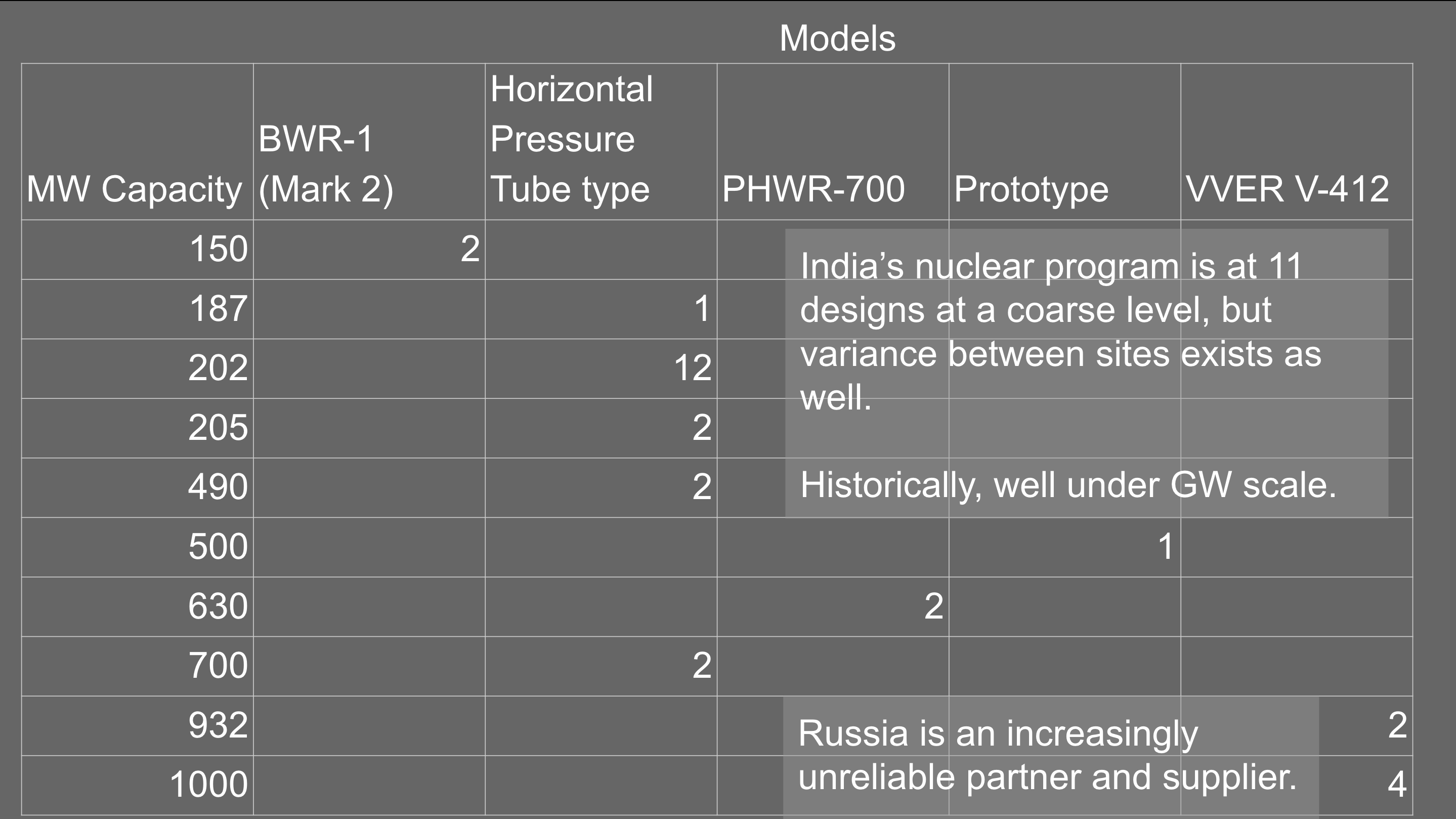
Here’s to the point of India’s design challenges. This is the table of all the different designs of nuclear models that India has built. Every scale, every megawatt of capacity for a specific type of technology ends up being a different design. It’s just the nature of the beast. You’ve got to adjust a whole bunch of stuff, and you’ve got to spend a lot of time engineering money trying to figure this out. As you can see, this is spread quite substantially from tiny reactors, lots of tiny reactors. Historically, India started to figure out the gigawatt-scale is more important, as everybody does. This is historically. We can look back to the early days of the industry in the United States, where they’re basically taking pressurized water reactors out of nuclear submarines and nuclear aircraft carriers and putting them on land as commercial generation units.
And what they found was that the economics required for military nuclear-powered submarines and aircraft carriers were very different than what people were willing to pay for power to keep their lights on. And so that was very expensive. And that’s why the United States, as every other geography did, immediately scaled up to gigawatt-scale quite soon after that. India is actually an interesting outlier, and perhaps I’ll understand that at some point, but you built a lot of small reactors. It’s unclear why you were building them long after other geographies had abandoned that scaling, but still, you’ve got a lot of small ones.
And now we sit here and say, here’s your current reactors. These are VVERs and those are Russian reactors. And unfortunately, while I know that India has stayed relatively neutral in terms of the Ukraine invasion, it’s not like Russia looked at strategically, is an increasingly reliable or dependable strategic partner. It at best is a member of BRICS that you kind of look at and go, you know, okay, they’re in the group with us, but if we had to depend on somebody, would they be the country we depend on? The challenges they brought on themselves with the restrictions has meant that their high tech suffered radically and to a much greater extent. It’s much harder for them to get stuff. Their market for the yellow cake and the HALEU and stuff that they were once they’d locked up the market in high assay, low enrichment uranium, and now that’s gone away, and the United States is building a consortium to displace Russian HALEU.
It’s not a great country to rely on and a natural industry to rely on for India’s development in this space. It’s a higher risk choice, in other words, and it adds a risk. They’ve become effectively an international rogue state, and that’s problematic. So strategically, having six reactors under construction, these are the fairly modern ones that are being built, becomes more at risk, and it really does bring into question the geopolitical choice and risks associated with the future of India’s nuclear program. You’re not alone in facing this. Russia was actually an exporter of nuclear generation to multiple countries, and now all of them are questioning that.

So let’s finish on small modular nuclear reactors now. Small modular nuclear reactors? Well, they claim to solve the problem with nuclear generation, just as the AP 1000 claimed to solve the problem, just as various other innovations have claimed to solve the problem. But basically they’re only solving this problem. Build lots and deploy them rapidly. They’re ignoring single proven gigawatt-scale design. Last time I counted, there are 18 different designs of small modular reactors, all competing for anybody to buy them, and none have been deployed. They’re all trying to pretend that innovation is the answer in nuclear. When innovation is proven not to be the answer in nuclear, they’re pretending that the national priority, national control, and national human resources aren’t required, instead pretending that they’re kind of a free market, competitive solution.
The small modular reactor types really kind of ignored the lessons of the past and the ongoing relearning of those lessons as they moved forward. And so small modular reactors aren’t a solution. You know, people are starting to realize that as they fail globally, as the price points come in and everybody’s like, got sticker shock, and it was entirely predictable. I predicted it years ago and published on that as well.
So that’s it. There’s a couple of questions. We have time for them, but let’s stop with that for now.
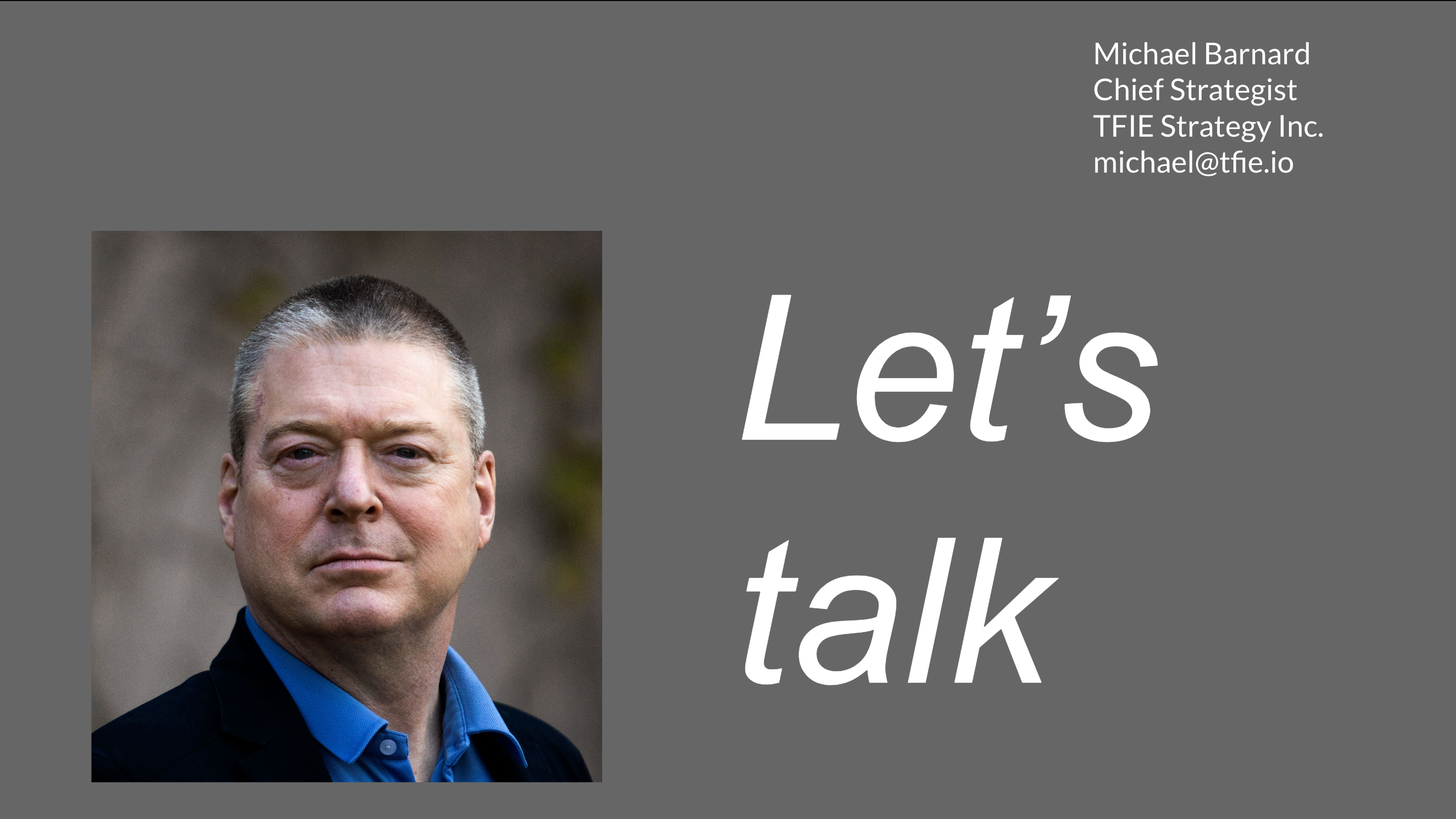
Question: How was France able to scale its nuclear program, and what have been the implications for the country with such a large percentage of electricity from nuclear?
Answer: So I tend to call France’s nuclear, Europe’s nuclear. The last time I did the math on it, the nuclear generation in France represented 13% of electrical generation in Europe. The cross-border net transmission flows with every surrounding country and France are very high. I mean, the net generation, the net terawatt-hours are in the double digits in all directions. What this means is that France is running its nuclear plants at full capacity as base load for Europe, and people are turning down or off their coal and gas generation plants at night in Europe. It’s not France, it’s Europe. You have to think about it in that way.
If France was building their nuclear program solely for themselves and solely for their own country, they would have to run it at much lower capacity factors than even they have done historically. And it would be even more expensive. And the expense is a challenging one in France, once again, I said reasonably expensive, reasonably successful. I add France into that category. But Macron, the current president of France, used to run the organization that kept track of money for the government in France. And when he was in that role, he tried really hard to figure out how much they actually spent on their nuclear program and could never get to the bottom of it. He’s on public record as saying, I don’t know how much. I couldn’t figure out how much we spent.
Part of the advantage of a national high level priority is money gets found or hidden. There are slush funds, there’s alternate lines, creative ways of accounting so that the program gets through. Part of the problem with that is you don’t know how much was actually spent. In Ontario for example, in the 1990s is when the electrical system was liberalized by the then government, which made a bunch of other, that I will just say, poorly thought through, rash decisions that could have been implemented much better. One of the things they did is they took $20 billion worth of debt out of the nuclear program and put it into a general slush fund. It moved it to a different accounting thing, so the electrical system looked good.
And then a couple of decades later, it kind of moved back into the electrical system and it hasn’t been paid down. So we’ve been paying the interest on that nuclear for a long time. It’s a plus and minus if there are cost overruns, if it’s a national program, it’s easy to get it paid, but sometimes it’s hard to figure out what it is. France’s nuclear program exists in a certain context. It exists in a context where it is a small percentage of total nuclear generation that can afford to be relatively inflexible because it was a governmental nationalized build-out on governmental largesse, and so pure economics didn’t account for that, which is okay. One of the things I say is that nuclear programs are incompatible with free market economics.
But if a country or a region creates all those conditions for success and successfully scales a lot of nuclear, I’m a happy guy, because nuclear is good. It’s suboptimal, but it’s better than building a lot of coal.
Have a tip for CleanTechnica? Want to advertise? Want to suggest a guest for our CleanTech Talk podcast? Contact us here.
Latest CleanTechnica.TV Videos
CleanTechnica uses affiliate links. See our policy here.
CleanTechnica’s Comment Policy





